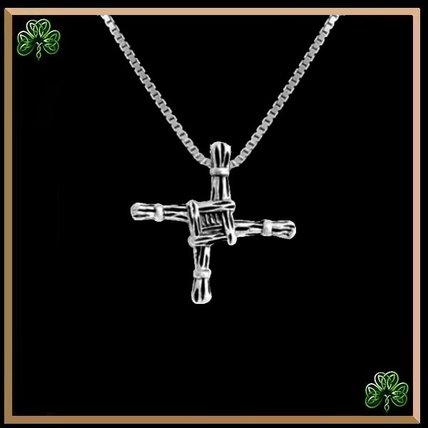ST BRIGID CELTIC CROSS
This exquisite solid silver Celtic cross is a miniature reproduction of a freestanding cross located in a ruined churchyard in Brigid, Ireland.
The Brigid Celtic cross is a 3/4 " across by 3/4' long. It has a polished back, stamped sterling. The front of the cross is antiqued and extremely detailed. This cross includes an 18" sterling silver chain.
A longer chain can be ordered here.
$19.98 USD
The Brigid Celtic cross is a 3/4 " across by 3/4' long. It has a polished back, stamped sterling. The front of the cross is antiqued and extremely detailed. This cross includes an 18" sterling silver chain.
A longer chain can be ordered here.
$19.98 USD
ST. BRIGID CELTIC CROSS
Brigid, Ireland
Saint
Brigid, second only to St Patrick as the patron saint of Ireland, is
also commonly known as Saint Bride or Bridget (451-523AD). According to
tradition, she was a woman of great beauty and ability. She was
brought up in a Druid household, but not wishing to marry her chosen
suitor, at the age of 14, she went to live as one of the first nuns in
a small convent under a large oak. The monastery of Kildare was later
founded there. The name Kildare means Church of the Oak. (She was also
the patroness of the Knights of Chivalry and it is suggested that the
word bride entered the English language because these knights married
women who became their very own 'brides'.)
It is a traditional Irish story, that while teaching a dying old man about Christianity, St. Brigid made a cross from rushes in order to explain the crucifixion and the message of salvation. This was the first St Brigid's Cross. St Brigid Crosses were hung in stables and houses to bring protection to the family and animals. Even to this day similar crosses are made, and placed in the rafters of a dwelling to protect from harm.
The feast day of Saint Brigid is celebrated on the first day of February, the supposed day of her death (This is also the date of the Celtic fire festival of Imbolc, celebrating the return of light after the darkness of winter.) As this is the first day of spring also in the Celtic calendar, it was an important time for farmers as it was a sign of the end of winter. So to see a hedgehog was supposed to be a good sign, because he wouldn't come out if he thought that the weather wasn't going to be good. In Scotland, the oystercatcher is known as Gillebridean, the 'Guide of St Bride', for she was supposed to send the birds to guide sailors to safety.
It is a traditional Irish story, that while teaching a dying old man about Christianity, St. Brigid made a cross from rushes in order to explain the crucifixion and the message of salvation. This was the first St Brigid's Cross. St Brigid Crosses were hung in stables and houses to bring protection to the family and animals. Even to this day similar crosses are made, and placed in the rafters of a dwelling to protect from harm.
The feast day of Saint Brigid is celebrated on the first day of February, the supposed day of her death (This is also the date of the Celtic fire festival of Imbolc, celebrating the return of light after the darkness of winter.) As this is the first day of spring also in the Celtic calendar, it was an important time for farmers as it was a sign of the end of winter. So to see a hedgehog was supposed to be a good sign, because he wouldn't come out if he thought that the weather wasn't going to be good. In Scotland, the oystercatcher is known as Gillebridean, the 'Guide of St Bride', for she was supposed to send the birds to guide sailors to safety.



